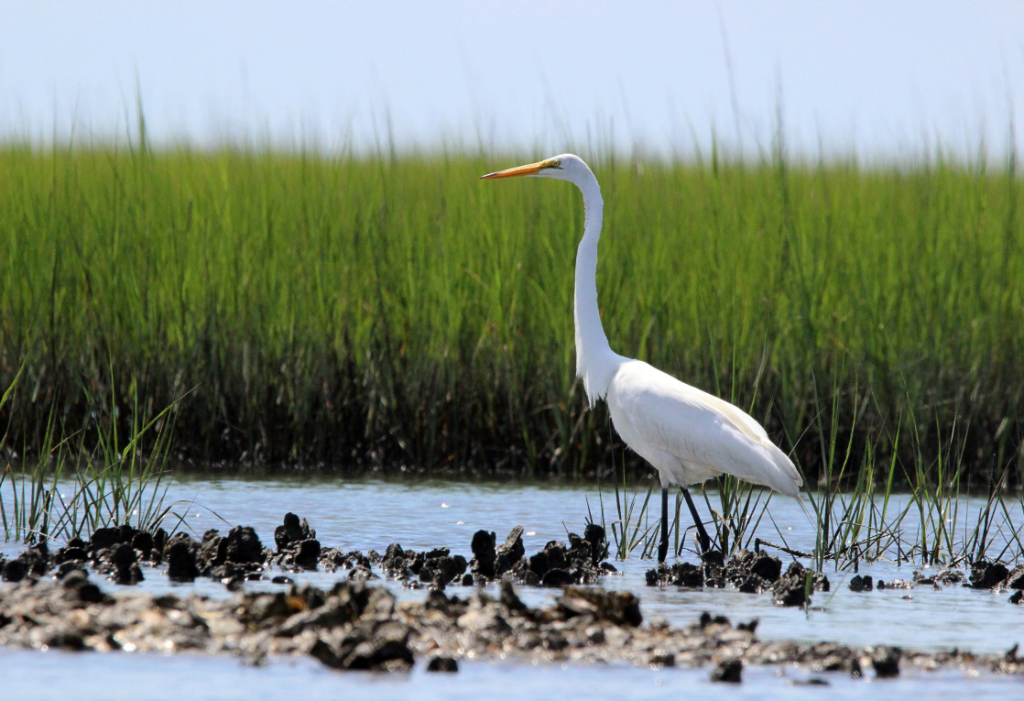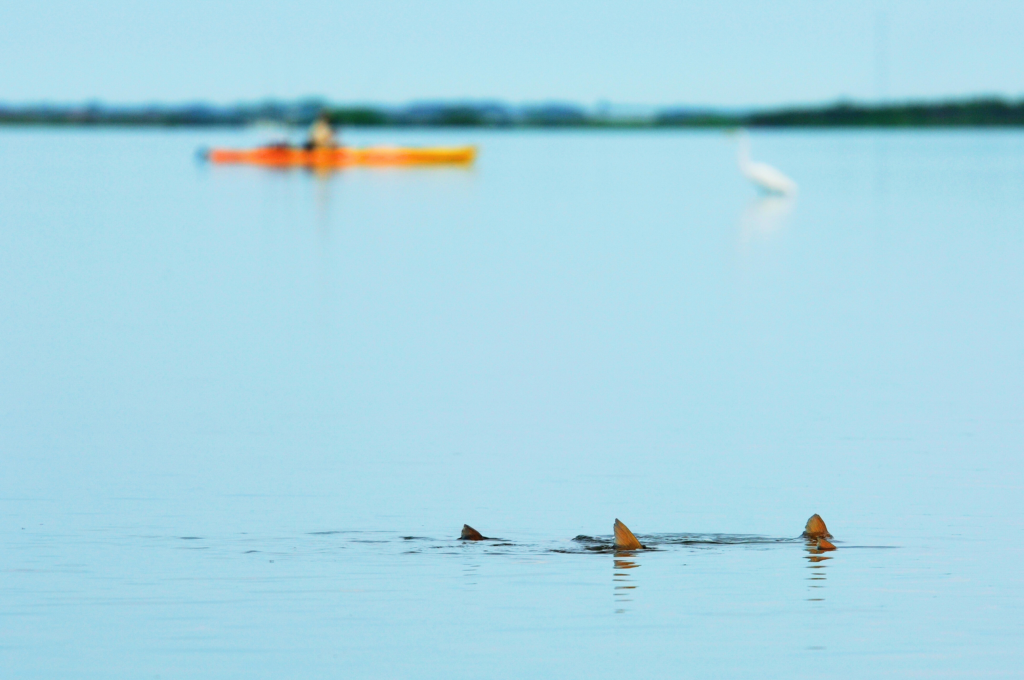With the smell of salt on the breeze and views of shimmering mudflats blending into blue as they fade into the distant waters, there’s no question that North Carolina’s estuaries are beautiful. Whether you come here to find the solace of nature or have built your life around these waterways, there’s a reason they feel like a refuge for many of us.
North Carolina’s estuaries form a diverse network between the rivers and the ocean that supports ecosystems, fuels local economies, and enhances our coastal communities. But what exactly makes these estuaries so special, and why should we care?
In this article, we’ll explore the science behind estuaries, highlight their ecological and economic value, and uncover why protecting these irreplaceable coastal resources matters. Let’s dive in!
An Ecosystem in Flux: What is an Estuary?
An estuary is a body of water that forms when freshwater from a river or stream mixes with saltwater from the ocean. The resulting water is brackish, meaning it’s salty but not as salty as the ocean. These conditions create a range of diverse habitats, including salt marshes, mudflats, and seagrass beds. As we see across the world’s biomes, diverse habitats support greater diversity in life! This brackish water opens up ecological niches for an impressive range of plants and animals.
We’ll dig more into the incredible ecology of estuaries in the next section, but first, we’ll overview the different types of estuaries and explain some of the factors that create these amazing ecosystems.
Types of Estuaries
Interestingly, an estuary doesn’t form at every river mouth. In most cases, the freshwater disperses into the ocean. Estuaries are like a container; the landscape creates a partially enclosed area that allows the saltwater and freshwater to mix. There are a few different types of estuaries named for the geologic events that created them.
Fun fact: Estuaries can also be entirely freshwater! When warmer waters of a river flow into a cooler lake, a process called “lake turnover” occurs. Similarly to a saltwater estuary, this mixing creates shifting aquatic ecosystems that support greater biodiversity.
Cycles of Change: The Impact of Tides and Seasons
One thing that’s consistent about estuaries is that they are always changing. The cyclical nature of tides, rainfall, and climate means that the ratio of saltwater to freshwater is constantly in flux.
Take the tides, for example. As high tide comes in, it raises both the water level and the salinity of the estuary, creating what we call an estuarine current. Because saltwater is heavier than freshwater, this current moves near the bottom, while the less dense freshwater from the river flows near the surface — a process called the anti-estuarine current. These currents are always cycling, but their strength shifts depending on the tide and river flow.
Seasonal changes, like heavy rains or droughts, add another layer of variability. During the rainy season, rivers swell and pour more freshwater into the estuary, pushing back the salty intrusion. In dry periods, river flow slows, allowing saltwater to push farther inland.
On both a daily and seasonal basis, these natural cycles shape the surrounding ecosystems and economies that have long depended on estuaries for fishing, farming, and trade.
Types of Estuaries in North Carolina
In North Carolina, estuaries define the coastline. Our entire coastal region is dominated by the Albemarle-Pamlico Estuarine System. Covering over two million acres, it’s the second largest estuary system in the United States, stretching from the barrier islands of the Outer Banks in the east all the way inland towards the Raleigh-Durham region in the west. Of North Carolina’s twelve major rivers, seven empty into the estuaries along our coast (the other five meet the ocean in other states).
This massive estuarine system is a mosaic of interconnected sounds, bays, rivers, and inlets, shaping the region’s unique ecological and geographical characteristics. Among the most notable are the Pamlico Sound, Albemarle Sound, and Cape Fear River Estuary. These estuaries formed primarily due to the barrier islands that protect the coast. However, rising sea levels at the end of the last ice age filled in some of the nearby river valleys, making North Carolina’s estuaries a combination of bar-built and coastal plain estuaries.
This expansive system is broken down into smaller sounds and lagoons to account for nuanced geologic and cultural differences. Bogue Sound, behind Bogue Banks, and Core Sound, between the mainland and Core Banks, are just two examples of the many smaller estuaries found on the North Carolina coast.

Why We Care: The Importance of North Carolina’s Estuaries
North Carolina’s estuaries are remarkable! The interplay of climate, geology, and topography has formed an array of ecosystems that have both an ecological and economic value.
Ecological Value
Fueled by cycling currents that deliver nutrients from both land and sea, estuaries are among the most productive ecosystems on Earth. The lush plant life found in marshes and seagrass beds offers critical shelter for countless marine species. Like a pyramid, the estuarine ecosystem is built from the bottom up—its strong foundation supports a wide variety of life higher up the food chain.
These sheltered habitats serve as nurseries for key forage species like Atlantic menhaden and striped mullet, as well as vital invertebrates such as shrimp, blue crabs, and oysters. Together, they form the foundation of the estuarine food web, supporting prized recreational and commercial species including flounder, speckled trout, red drum, and striped bass.
In addition to supporting wildlife, estuaries provide natural coastal defense by mitigating the damaging effects of storm surge and flooding. Plant life helps stabilize shorelines, reducing erosion and protecting coastal communities. At the same time, oysters naturally filter pollutants from the water, improving water clarity and enhancing overall ecosystem health.
Economic Value
Speaking of how estuaries benefit human economies, let’s take a closer look at the on-land value they drive. These rich, sheltered waters help power our food system, supporting a seafood industry that reaches far beyond our own shores. Nationally, estuaries provide nursery grounds for 75% of the fish and shellfish we eat, producing more food per acre than even the most fertile farmland in the country. Here at home, they help sustain more than 40,000 jobs from seafood harvesters and fishing guides to boat builders and marina crews. Healthy estuaries don’t just feed us, they keep our coastal communities thriving.

The Future of North Carolina’s Estuaries
North Carolina’s estuaries are beautiful coastal ecosystems that sustain diverse wildlife, enrich local economies, and make life brighter for residents and visitors alike. By understanding how estuaries form, recognizing their ecological significance, and appreciating their economic contributions, we can better appreciate their value.
As coastal populations expand, our estuaries face growing environmental stress. That’s why the future of these delicate ecosystems depends on a shared commitment to data-driven research and innovation. With the help of cutting-edge science and technology, we can determine how human activity and environmental change are impacting North Carolina’s fisheries and coastal resources.
Ultimately, the health of North Carolina’s estuaries depends on coordinated actions among scientists, policymakers, communities, and citizens. That’s where the North Carolina Marine & Estuary comes in. Along with supporting research and education, we find ways to engage stakeholders in the conversation about the future of these ecosystems. We’d love to include you in the process! Subscribe to our newsletter and stay up to date on our efforts to build world-class fisheries and thriving coastal economies by strengthening our estuaries and beyond.

